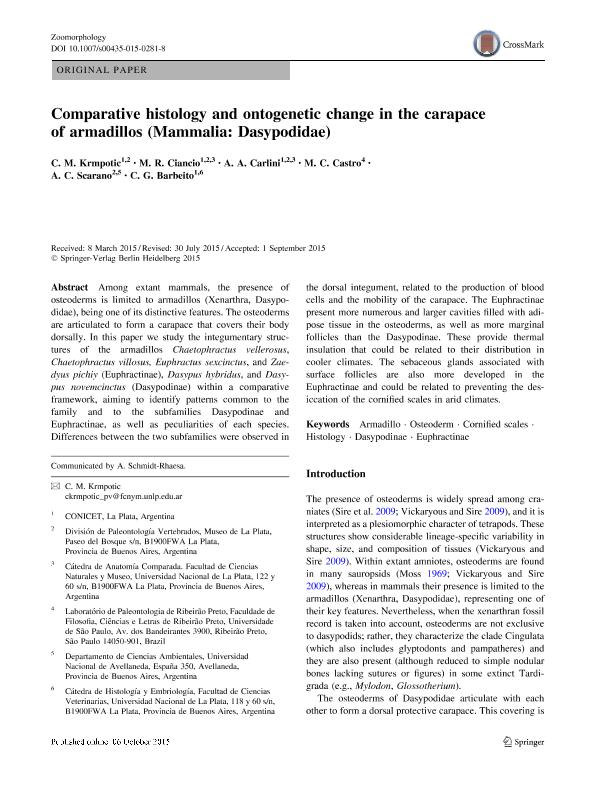Artículo
Comparative histology and ontogenetic change in the carapace of armadillos (Mammalia: Dasypodidae)
Krmpotic, Cecilia Mariana ; Ciancio, Martin Ricardo
; Ciancio, Martin Ricardo ; Carlini, Alfredo Armando
; Carlini, Alfredo Armando ; Castro, Mariela C.; Scarano, Alejo Carlos
; Castro, Mariela C.; Scarano, Alejo Carlos ; Barbeito, Claudio Gustavo
; Barbeito, Claudio Gustavo
 ; Ciancio, Martin Ricardo
; Ciancio, Martin Ricardo ; Carlini, Alfredo Armando
; Carlini, Alfredo Armando ; Castro, Mariela C.; Scarano, Alejo Carlos
; Castro, Mariela C.; Scarano, Alejo Carlos ; Barbeito, Claudio Gustavo
; Barbeito, Claudio Gustavo
Fecha de publicación:
12/2015
Editorial:
Springer
Revista:
Zoomorphology (Berlin. Print)
ISSN:
0720-213X
Idioma:
Inglés
Tipo de recurso:
Artículo publicado
Clasificación temática:
Resumen
Among extant mammals, the presence of osteoderms is limited to armadillos (Xenarthra, Dasypodidae), being one of its distinctive features. The osteoderms are articulated to form a carapace that covers their body dorsally. In this paper we study the integumentary structures of the armadillos Chaetophractus vellerosus, Chaetophractus villosus, Euphractus sexcinctus, and Zaedyus pichiy (Euphractinae), Dasypus hybridus, and Dasypus novemcinctus (Dasypodinae) within a comparative framework, aiming to identify patterns common to the family and to the subfamilies Dasypodinae and Euphractinae, as well as peculiarities of each species. Differences between the two subfamilies were observed in the dorsal integument, related to the production of blood cells and the mobility of the carapace. The Euphractinae present more numerous and larger cavities filled with adipose tissue in the osteoderms, as well as more marginal follicles than the Dasypodinae. These provide thermal insulation that could be related to their distribution in cooler climates. The sebaceous glands associated with surface follicles are also more developed in the Euphractinae and could be related to preventing the desiccation of the cornified scales in arid climates.
Palabras clave:
ARMADILLO
,
CORNIFIED SCALES
,
DASYPODINAE
,
EUPHRACTINAE
,
HISTOLOGY
,
OSTEODERM
Archivos asociados
Licencia
Identificadores
Colecciones
Articulos(CCT - LA PLATA)
Articulos de CTRO.CIENTIFICO TECNOL.CONICET - LA PLATA
Articulos de CTRO.CIENTIFICO TECNOL.CONICET - LA PLATA
Citación
Krmpotic, Cecilia Mariana; Ciancio, Martin Ricardo; Carlini, Alfredo Armando; Castro, Mariela C.; Scarano, Alejo Carlos; et al.; Comparative histology and ontogenetic change in the carapace of armadillos (Mammalia: Dasypodidae); Springer; Zoomorphology (Berlin. Print); 134; 4; 12-2015; 601-616
Compartir
Altmétricas



